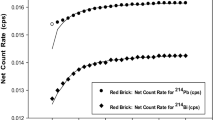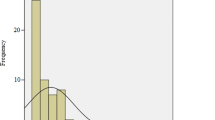Abstract
This paper presents the results of an effort to evaluate anthropogenic doses in bricks from old buildings located on the banks of the Techa River. The river area was contaminated in 1949–1956 as a result of radioactive waste releases by the Mayak plutonium facility (Southern Urals, Russia). Absorbed doses were determined by luminescence measurements of quartz extracted from the near-surface layers of bricks sampled in 1991–1997 from three remained buildings (a mill, a granary and a church). These buildings are located in the former residence area of Metlino, which was the settlement located closest to the release site (residents of Metlino were relocated from the contaminated river in 1956). The measured anthropogenic dose in the three buildings was found to be comparable: minimum values were equal to 0.5–0.9 Gy and maximum values amounted to about 3–4 Gy. Unfortunately, the geometry of gamma-exposure of the brick samples changed significantly in 1956 as a result of creation of an artificial reservoir downstream of the Metlinsky pond. Since luminescence data provide absorbed dose in the investigated samples accumulated over the whole period of irradiation, for interpretation of the data obtained it is important to know the exposure geometry for the period of maximal exposure, which was in the early 1950s. In 2005, archival data describing configuration of contaminated water streams and shorelines (which were the main sources of gamma-irradiation) were published. Comparison of these data with the results of the luminescence study presented here showed that the bricks with the highest thermoluminescence (TL)-based doses faced contaminated shores and were located close to them. In contrast, the bricks with lower values of measured dose were opposite to contaminated shores and/or being shielded. This demonstrates that the luminescence method allowed reconstruction of the anthropogenic dose distribution in the former settlement center. The obtained results suggest new options for further luminescence studies in Metlino aimed at the reconstruction of the external exposures of the affected population.






Similar content being viewed by others
References
Kossenko MM, Preston DL, Krestinina LY, Degteva MO, Startsev NV, Thomas T, Vyushkova OV, Anspaugh LR, Napier BA, Kozheurov VP, Ron E, Akleyev AV (2002) Studies on the extended Techa River cohort: cancer risk estimation. Radiat Environ Biophys 41:45–48
Krestinina LY, Preston DL, Ostroumova EV, Degteva MO, Ron E, Vyushkova OV, Startsev NV, Kossenko MM, Akleyev AV (2005) Protracted radiation exposure and cancer mortality in the Techa River cohort. Radiat Res 164:602–611
Anspaugh LR, Degteva MO, Vorobiova MI, Mokrov YG, Napier BA (2006) Dosimetry for members of the Extended Techa River Cohort. Health Phys 91:393–394
Balonov M, Alexakhin R, Bouville A, Liljinzin JO (2006) Report from the Techa River dosimetry review workshop held on 8–10 December, 2003, at the State Research Centre Institute of Biophysics, Moscow, Russia. Health Phys 90:97–113
Keirim-Markus IB, Youganova TI (2005) On radiation risk evaluation for the population of the Techa River catchment-area contaminated due to “Mayak” Production Association activities. Med Radiol Radiat Safety 50:18–24 (in Russian)
Kellerer AM (2002) The Southern Urals radiation studies. A reappraisal of the current status. Radiat Environ Biophys 41:307–316
Eidemüller M, Ostroumova E, Krestinina L, Akleyev A, Jacob P (2008) Analysis of solid cancer in the Techa River Cohort using the two-step clonal expansion model. Radiat Res 169:138–148
Krestinina LY, Davis F, Ostroumova EV, Epifanova SB, Degteva MO, Preston DL, Akleyev AV (2007) Solid cancer incidence and low-dose-rate radiation exposures in the Techa River cohort: 1956–2002. Int J Epidemiol 36:1038–1046
Degteva MO, Vorobiova MI, Kozheurov VP, Tolstykh EI, Anspaugh LR, Napier BA (2000) Dose reconstruction system for the exposed population living along the Techa River. Health Phys 78:542–554
Degteva MO, Kozheurov VP, Tolstykh EI, Vorobiova MI, Anspaugh LR, Napier BA, Kovtun AN (2000) The Techa River dosimetry system: methods for the reconstruction of internal dose. Health Phys 79:24–35
Degteva MO, Vorobiova MI, Tolstykh EI, Shagina NB, Shishkina EA, Anspaugh LR, Napier BA, Bougrov NG, Shved VA, Tokareva EE (2006) Development of an improved dose reconstruction system for the Techa River population affected by the operation of the Mayak Production Association. Radiat Res 166:255–270
Napier BA, Shagina NB, Degteva MO, Tolstykh EI, Vorobiova MI, Anspaugh LR (2001) Preliminary uncertainty analysis for the doses estimated using the Techa River Dosimetry System—2000. Health Phys 81:395–405
Vorobiova MI, Degteva MO, Burmistrov DS, Safronova NG, Kozheurov VP, Anspaugh LR, Napier BA (1999) Review of historical monitoring data on Techa River contamination. Health Phys 76:605–618
Eckerman KF, Ryman JC (1993) External exposure to radionuclides in air, water, and soil. Federal Guidance Report No. 12, EPA 402-R-93-081, U.S. Environmental Protection Agency, Washington
Vorobiova MI, Degteva MO (1999) Simple model for the reconstruction of radionuclide concentrations and radiation exposures along the Techa River. Health Phys 77:142–149
Jacob P, Göksu HY, Taranenko V, Meckbach R, Bougrov NG, Degteva MO, Vorobiova MI (2003) On an evaluation of external dose values in the Techa River Dosimetry System (TRDS) 2000. Radiat Environ Biophys 42:169–174
Taranenko V, Meckbach R, Degteva MO, Bougrov NG, Göksu Y, Vorobiova MI, Jacob P (2003) Verification of external exposure assessment for the Upper Techa Riverside by luminescence measurements and Monte Carlo photon transport modeling. Radiat Environ Biophys 42:17–26. Erratum in Radiat Environ Biophys 2004 42:295
Degteva MO, Anspaugh LR, Akleyev AV, Jacob P, Ivanov DV, Wieser A, Vorobiova MI, Shishkina EA, Shved VA, Vozilova AV, Bayankin SN, Napier BA (2005) Electron paramagnetic resonance and fluorescence in situ hybridization-based investigations of individual doses for persons living at Metlino in the upper reaches of the Techa River. Health Phys 88:139–153
Bougrov NG, Vlasov VK, Kiryukhin OV, Fatkulbayanova NL (1995) Thermoluminescence measurements of ceramic samples from accidentally polluted territory of Southern Urals. Radiat Meas 24:493–498
Göksu HY, Heide LM, Bougrov NG, Dalheimer AR, Meckbach R, Jacob P (1996) Depth-dose distribution in bricks determined by thermoluminescence and by Monte-Carlo calculation for external γ-dose reconstruction. Appl Radiat Isot 47:433–440
Meckbach R, Bailiff IK, Göksu HY, Jacob P, Stoneham D (1996) Calculation and measurement of depth dose distribution in bricks. Radiat Prot Dosimetry 66:183–186
Bougrov NG, Göksu HY, Haskell E, Degteva MO, Meckbach R, Jacob P (1998) Issues in the reconstruction of environmental doses on the basis of thermoluminescence measurements in the Techa Riverside. Health Phys 75:574–583
Bougrov NG, Degteva MO, Göksu HY, Meckbach R, Jacob P (2001) Retrospective thermoluminescence dosimetry in the riverside territories of the upper-Techa River. Radiat Safety Problems 3:51–62 (in Russian)
Bougrov NG, Baturin VA, Göksu HY, Degteva MO, Jacob P (2002) Investigation of thermoluminescence dosimetry in the Techa River flood plain: analysis of the new results. Radiat Prot Dosimetry 101:225–228
Mokrov YG, Stukalov PM, Martyushov VZ (2005) On the problem of external exposure dose estimation for Metlino residents (Techa River, Chelyabinsk region) in the early 1950s. Radiat Safety Problems 4:51–57 (in Russian)
Göksu HY, Degteva MO, Bougrov NG, Meckbach R, Haskell EH, Bailiff IK, Bøtter-Jensen L, Jungner H, Jacob P (2002) First international intercomparison of luminescence techniques using samples from the Techa River valley. Health Phys 82:94–102
Bailiff IK, Botter Jensen L, Correcher V, Delgado A, Göksu HY, Junger H, Petrov SA (2000) Absorbed dose evaluation in retrospective dosimetry: methodological developments using quartz. Radiat Meas 32:609–613
ICRU (2002) Retrospective assessment of exposures to ionising radiation. International commission on radiation units and measurements report 68. Journal of the ICRU 2 (2). Oxford University Press, Oxford
Göksu HY, Bulur E, Wahl W (1999) Beta dosimetry using thin-layer α-Al2O3:C TL detectors. Radiat Prot Dosimetry 84:451–455
Choupin N (1873) Geographical and statistical dictionary of the Perm region. Popova’s publishing house, Perm (in Russian)
Acknowledgments
This work was funded by the EU under contract number FP-516478 (SOUL). The authors thank Sergey Rovny, Yuri Mokrov and Pavel Stukalov (the ‘Mayak’ Production Association) for allowing to work with archival documents describing the Metlino hydroscheme in the period of the Techa River contamination. Also, we thank Evgenia Tolstykh and Viktor Krivoschapov (URCRM) for their help in preparation of the illustrations.
Author information
Authors and Affiliations
Corresponding author
Rights and permissions
About this article
Cite this article
Degteva, M.O., Bougrov, N.G., Vorobiova, M.I. et al. Evaluation of anthropogenic dose distribution amongst building walls at the Metlino area of the upper Techa River region. Radiat Environ Biophys 47, 469–479 (2008). https://doi.org/10.1007/s00411-008-0183-y
Received:
Accepted:
Published:
Issue Date:
DOI: https://doi.org/10.1007/s00411-008-0183-y




